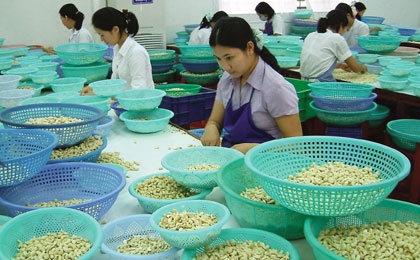Agriculture exports blossoming
 |
| Agricultural exporters have come up smelling of roses |
The Ministry of Agriculture and Rural Development (MARD) reported that in the first eight months of this year, the country’s agro-forestry-aquatic sector’s trade surplus hit $3.7 billion. Specifically, the sector’s total export and import turnovers were estimated at $12.2 billion and $8.5 billion, up 20.1 and 28.9 per cent respectively against last year’s corresponding period.
Meanwhile, the Ministry of Planning and Investment’s General Statistics Office reported that Vietnam’s trade deficit in 2010’s first eight months was more than $8 billion, occupying 18.3 per cent of the country’s total export turnover.
During January and August, the country’s total export and import turnovers were estimated at $44.52 billion and $52.7 billion, up 19.7 and 24.4 per cent respectively against last year’s corresponding period.
“Vietnam’s agro-forestry-aquatic sector has enjoyed favourable conditions such as high export prices and international market’s swelling demand,” said Nguyen Viet Chien, director of MARD’s Centre for Informatics and Statistics.
For example, Chien said, in the first eight months of the year, the export turnover of agricultural staples, seafood and forestry products were $6.5 billion, $2.95 billion and $2.28 billion, up 16.6, 12.9 and 35.5 per cent respectively compared to the same period last year.
The European Union remains a major importer of made-in-Vietnam seafood. Between January and August, it bought over 200,000 tonnes of Vietnamese seafood worth $621 million, up 5.1 per cent in quantity and 7.6 per cent in value against last year’s corresponding period, accounting for 28.5 per cent and 25 per cent of the country’s total seafood export volume and turnover. Meanwhile, Vietnam’s seafood exported to Japan and the United States also enjoyed a 20 per cent increase each against 2009’s corresponding period.
“In fact, the sector has always kept a firm trade surplus over the past few years, especially since 2008 when the global financial affected Vietnam’s export markets,” Chien said.
For instance, although Vietnam suffered from trade deficit of $17.5 billion and $12.2 billion in 2008 and 2009, the country’s agro-forestry-aquatic sector witnessed big trade surplus of $6.7 billion in 2008 and $10.3 billion in 2009.
Le Dang Doanh, a local independent economist, said the sector principally imported animal feed, fertilisers and pesticides, the prices of which were obviously lower than those of raw materials needed by industrial sector.
“Meanwhile, the sector’s added value is over 30 per cent - the highest level among other sectors’ in the economy. For example, the added value is only 5-7 per cent for machinery and electronic products and 15-20 per cent for garments and textiles.
“Many parts of the world are depending on Vietnam’s agro-forestry-aquatic products. I think that the sector will continue with its trade surplus in the coming years,” Doanh said.
Pham Hoang Ngan, director of Hanoi-based Agrovietlink Corporation - a market analysis firm, however said the agro-forestry-aquatic sector needed increasing investment capital to improve its competitiveness.
“However, the public investment into this sector remains too weak, occupying an average 8.7 per cent of the country’s total social development investment funds annually,” Ngan said.
The MARD forecast that the country’s agro-forestry-aquatic sector this year would reach an export turnover of $16 billion, up $700 million against 2009, thanks to the global market’s recovery.
What the stars mean:
★ Poor ★ ★ Promising ★★★ Good ★★★★ Very good ★★★★★ Exceptional
 Tag:
Tag:
Related Contents
Latest News
More News
- Two national hospitals expand capacity with new facilities (December 20, 2025 | 09:00)
- Ha Tinh breaks ground on major Vingroup industrial and energy projects (December 19, 2025 | 18:24)
- EVN launches major power infrastructure projects nationwide (December 19, 2025 | 18:17)
- VAL inaugurates second production line to meet domestic animal feed demand (December 19, 2025 | 16:37)
- Sun Group pioneers urban tram system in Phu Quoc (December 19, 2025 | 15:00)
- Seven major projects launched to drive Hanoi’s next growth phase (December 19, 2025 | 14:00)
- Securing capital and efficiency for Vietnam’s 2026-2030 growth ambitions (December 17, 2025 | 10:00)
- Vietnam bucking trend in the global M&A landscape (December 16, 2025 | 14:20)
- HDS Summit spotlights Vietnam’s rising role in regional supply chains (December 16, 2025 | 08:00)
- Kolon signs $48 million airbag supply deal with Autoliv (December 15, 2025 | 18:14)
























 Mobile Version
Mobile Version